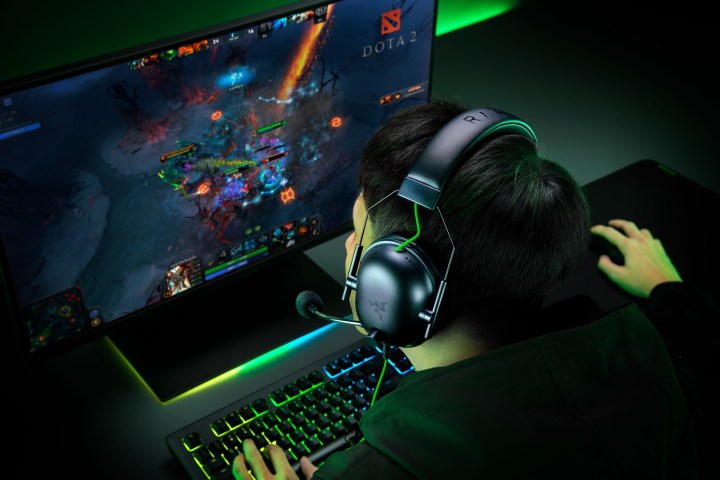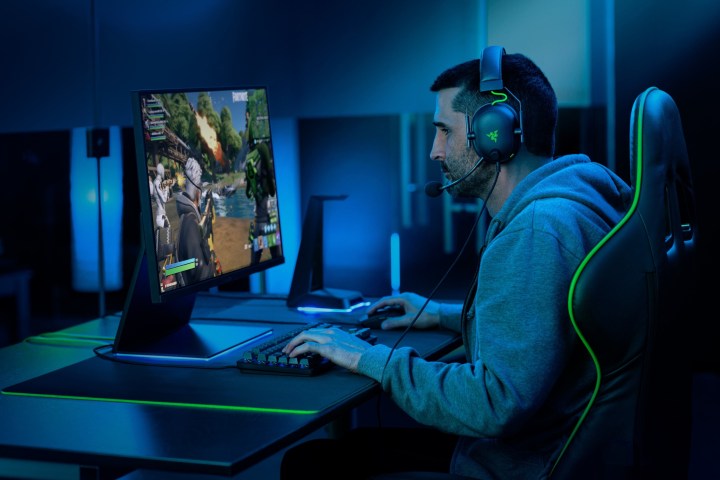- Sound profiles and easy customization
- Solid audio
- Superior mic performance
- Clunky design

The Razer BlackShark V2 — and by extension, the cheaper V2 X — offers exceptional performance at an exceptional price. The BlackShark V2 combines quality audio with the much rarer solid mic performance.
THX Game Profiles are easily the best feature of this headset.
The $100 base price also makes this headset an outstanding value. There are plenty of cheaper models, including the $60 V2 X, but few pack as many features as the BlackShark. Many of Digital Trends’ top gaming headset picks go for more than double the price of the BlackShark.
Sound profiles
THX Game Profiles are easily the best feature of the BlackShark V2, allowing you to tweak the EQ settings for every game individually. It comes preset with profiles for several popular games, including Apex Legends, Counter-Strike: Global Offensive, and Valorant. Not every game has a preset profile, but the Razer Synapse app makes it easy to change the settings regardless; you’ll just have to do more of the work yourself.
The cheaper V2 X omits THX Spatial Audio out of the box, but you can add it on using the app for $20. Considering the total cost of $80 for the headset and app, it’s not a bad deal, and you’ll get most of the flagship V2’s best features at a slight discount. It also works much better than some of the spatial audio we’ve seen, which tries and often fails to mimic the feeling of surround sound.
A lot of hardware and accessory makers play up how a product will increase the “immersion,” or feeling of really being inside the game. Most times, that’s just marketing, but this honestly feels incredible. For instance, the EQ settings let you dial up the level of footsteps in first-person shooters, or the music and environment sounds in a game like Death Stranding. Of course, this doesn’t translate to consoles, but it’s a fantastic experience on PC. But the right audio equipment can make a difference on consoles as well, and the BlackShark V2 certainly did. I was thrilled to boot up Ghost of Tsushima and listen to the wind rustle, or Resident Evil 3, where I’ve enjoyed using sound as a strategy.
The triple drivers are meant to isolate treble, bass, and midtones, the last of which often gets ignored. It’s a small difference, but I certainly noticed the extra details.

Mic check
It’s easy to ignore the importance of a headset’s mic quality — after all, how often do you listen to yourself? But you’ve probably felt the frustration of a muddy-sounding teammate, or someone drowned out by background noise, especially when competing with game sounds.
The mic is very flexible, and I found it easy to put into an optimal position, so that my AC blaring in the background was less of an issue. The foam mic cover also smooths out the sound, avoiding harsh consonant sounds. This is especially important if you also want to use the BlackShark for streaming, where small details can mean getting a new follower or having a viewer click off.
The mic is also detachable, which is a nice bonus for storage or travel, and it’s more accessible for possible replacement. I also find that detachable mics are usually longer and more flexible than built-in ones that need to fold up or coil back into the headset.
Working from home, my preferred gaming headset of the moment often pulls double duty. I find myself reaching for a headset for Zoom calls, Spotify sessions, and gaming breaks once I virtually clock out. Audio is less important for work meetings, but I’ve had people comment on how clear I sounded on a video call, in addition to in games.

Mirror models
My biggest qualm exists in both headsets: The look.
The BlackShark V2 and V2 X are very similar. They might be too similar. Both are very comfortable, have good mic and audio quality, and are easy to use, but the higher-priced V2 does everything slightly better. The cheaper V2 X has somewhat less advanced foam for its ear cushions, the cable is rubber rather than threaded, it only connects via a 3.5 mm jack, and it doesn’t have “advanced mic control features.”
What matters, though, isn’t the list of details. It’s how they feel to use. And, quite frankly, the differences feel relatively minute in practice. That’s not a knock on the V2 so much as it is a testament to the V2 X. For anyone looking for a well-rounded entry-level headset, it’s worth taking a look at.
Still, I found myself gravitating toward the full V2. As small as those differences are, they’re still there. So if you’re willing to drop the $100, don’t settle if you don’t have to.
My biggest qualm exists in both headsets: The look.
I feel like a helicopter pilot wearing them. And it’s not just the mic, the cushion on which certainly adds to that effect, a fact I’m willing to put up with for the increased audio fidelity. The headsets can only be described as bulbous. And I’m sure part of that is hard to avoid. Razer did emphasize the triple drivers the BlackShark has, which are supposed to provide that fantastic sound. But I still didn’t always like wearing them for that reason. The headsets aren’t heavy, but they look clunky and awkward. And while I might care less if my gaming mouse isn’t the most aesthetically pleasing, others can see my headphones.
Our take
The Razer BlackShark V2 and V2 X are both solid headsets with a good price tag. The V2 is certainly better, but those looking to spend a bit less won’t be disappointed with the V2 X, either.
Is there a better alternative?
There are so many headsets available that you could easily paralyze yourself with choice. Yes, there are other good headsets at this price point, but the BlackShark V2 is better than average. And it works well across devices.
How long will it last?
Despite the construction differences between the two models, both are sturdy. They’re well-built and should last quite a while. The BlackShark V2’s THX Spatial Audio and game profiles are also a nice touch. I wouldn’t be surprised if we see more iterations of this feature in the future.
Should you buy it?
If you’re in the market for a good entry- to mid-level headset with quality audio and mic, definitely. It works very well if you’re into function over form. If aesthetics are a must, maybe it’s not for you.





